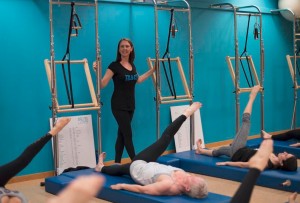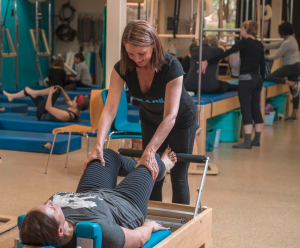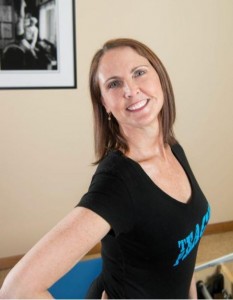Issue #261 – Wednesday, April 10, 2019
How the Classical Pilates Method’s Consistent Form Can Deepen Your Teaching Skills
By Amy Taylor Alpers
During more than 30 years of teaching Pilates, I have often been asked “How did you see that?” by observant students and clients. I used to say, “I don’t know, I just do.” But one time, a client replied, “That’s not good enough. You’re a teacher. You have to be able to teach people how to do that.” Pow!! So I embarked on a journey to figure out how I had learned to “see” what I was seeing. I have spent many years understanding this journey and I have realized one very key element to my deepening vision. I was working within a specific, codified movement form – the classical Pilates method – and that allowed me to focus all my creative energy on learning to “see”.
In other words, my mind and creative abilities weren’t constantly being taxed with developing new movement ideas, exercises, sequences, or lessons. Instead, I was watching hundreds of bodies doing the same movements over and over in a particular sequence until I could see well beyond the technique or form into the subtle differences of each unique individual’s way of moving. Only then could I begin to truly see and understand how their choice of movement patterning actually affected their whole body health. In turn, this enabled me to dive into a much deeper understanding of why the form was the way it was and why it works so well.
For instance, in the standard Reformer Footwork series, I can now see, almost instantly, the twists, tensions, compressions, misalignments, congestions, poor musculo-skeletal sequences, etc. that are making a person’s movement less effective. I even teach a workshop called Footwork – the Pilates Fortune Teller, because if you’re not constantly playing with choreography, you can instead put all your effort into seeing the energetic struggles. Therefore, instead of “teaching Pilates exercises to people”, I am actually spending all my time utilizing the entire system, as designed, to heal them.

The follow-up questions are generally: “How do you know what to say?” or “How do you trust your vision?” or “How did you become so confident in knowing what you thought was right?” Some thoughts on these are reflected in the material below.
Too much freedom in anything can simply lead to confusion and a lack of focus or intention on the teacher’s part – and consequently, the client’s. Resource abundance can actually be counterproductive. It can take you down the path of creating just to create (to keep clients always busy, entertained, learning something new) versus staying on the task of helping their minds (nervous systems) and bodies return back to moving the way they are naturally designed, which is where health resides.
Sometimes, when scrolling through social media, I am literally dumbfounded by what I see being done under the name “Pilates.” For instance, someone was pictured kneeling backward on a Reformer carriage, using the attached Tower system Push Through Bar at the back of the Reformer at the same time. This is simply inventing creative movements on Pilates equipment – to what end? – instead of using this purposefully designed system as intended – to heal the human body. If you love creating new movements for your students, that’s great, just don’t confuse it with the Pilates method.
When not constrained by a codified form, teachers may simply have no incentive to use what’s available to them in novel ways. When at a loss or confused (or maybe just bored?), they come up with something new instead. You may not ever see, for instance, that all Pilates extension exercises are essentially and fundamentally the same: they are all trying to free the spine where it is stuck and/or strengthen it where it is weak – so that it is simply a healthy, normal spine that moves like nature intended it to in the end. For instance, if a client is struggling with Pull Straps/T on the Reformer, take them to the mat and work on simply freeing, sequencing and strengthening their extension in the basic Swan. This fundamentally healthy movement skill will then take them all the way through the system’s methodical journey to Semi Circle, Thigh Stretch with Arch, Tree with Back Bend, and ultimately to Back Head Stands and High Bridge on the Reformer. It’s the same journey all the way through the system – returning a spine back to a healthy, normal, strong and flexible state – versus teaching it various unusual and separate exercises to perform or conquer.
 What makes the Pilates method so powerful and effective IS its systematic and intentionally designed form created to achieve a specific and unique goal – returning the body back to its automatic primal movement choices. The exercises, the order, and the sequences done on the right equipment – at tempo, repeated and repeated and repeated – enable the client to go very deep in their understanding and get a much more powerful mind/body innate connection of how to move wisely, safely and healthily.
What makes the Pilates method so powerful and effective IS its systematic and intentionally designed form created to achieve a specific and unique goal – returning the body back to its automatic primal movement choices. The exercises, the order, and the sequences done on the right equipment – at tempo, repeated and repeated and repeated – enable the client to go very deep in their understanding and get a much more powerful mind/body innate connection of how to move wisely, safely and healthily.
Are you simply teaching people interesting exercises to do, keeping them constantly learning something new, never really deepening their skills or achieving an intentional goal? Or are you healing people through returning their body back to the way it is ideally designed and organized so it can be healthy? The latter is what Joseph Pilates created his system to do. The form has a specific goal, and when used to achieve that, it works beautifully. If you are clear on the form AND its intention, then you can spend all your teaching time and energy toward a specific end. The form is not for form’s sake, it’s for its mission. Know the mission and you’ll understand the necessity of the form.
Limitations can broaden your perception and open up your thinking processes. Consistent constraints help you improve at connecting unrelated ideas and concepts. Embrace the design of the classical Pilates method. The form’s strict, premeditated, calculated, intentional approach is actually provocative. It challenges the teacher to dive deeper into its meaning and value. Its perceived limitations can actually wake up the power in you to be more creative, but for a specific mission. They can make you a better teacher and healer.
 Amy Taylor Alpers co-founded The Pilates Center (TPC) and The Pilates Center Teacher Training Program (TPCTTP) over 20 years ago in Boulder, Colorado. When not traveling the world to teach both foundational and graduate level Pilates teacher education she remains part of the core faculty for TPCTTP, mentors advanced teachers, teaches classes and sees clients. In addition to teaching TPC sponsored workshops, Amy has presented numerous times at the Pilates Method Alliance Annual Meeting, Balanced Body’s Pilates on Tour and Passing the Torch. In 2013, Amy presented at the Shared Traditions Conference for Fletcher Pilates and will present at The Pilates Roundtable.
Amy Taylor Alpers co-founded The Pilates Center (TPC) and The Pilates Center Teacher Training Program (TPCTTP) over 20 years ago in Boulder, Colorado. When not traveling the world to teach both foundational and graduate level Pilates teacher education she remains part of the core faculty for TPCTTP, mentors advanced teachers, teaches classes and sees clients. In addition to teaching TPC sponsored workshops, Amy has presented numerous times at the Pilates Method Alliance Annual Meeting, Balanced Body’s Pilates on Tour and Passing the Torch. In 2013, Amy presented at the Shared Traditions Conference for Fletcher Pilates and will present at The Pilates Roundtable.
Amy was born in Youngstown, Ohio where she began classical ballet at age two.
She attended The Juilliard School for Dance, danced with the Garden State Ballet in New Jersey, and received a B.A. in Dance and a M.A. in Dance History from New York University. In addition, Amy taught ballet at various dance schools in New York City for ten years before launching her Pilates career.
Both Amy and her sister Rachel studied Pilates under the direct tutelage of Romana Kryzanowska at the original Pilates Studio in New York City. They received their Pilates teaching certificate from there in July of 1989. In 1990, after moving to Boulder, Colorado, Amy and Rachel founded The Pilates Center. The sisters then created and established The Pilates Center Teacher Training Program in 1991. The school has since expanded to include an Intermediate Program, Advanced Program, Bridge Program, Master’s Program, and a Mentorship Program. In addition, TPC now has “Licensed” and “Host” studios established all around the world.
Amy and her sister wrote The Everything Pilates Book, published in 2002. She was a founding board member of the PMA and sat on the board that created the PMA Certification Exam. Recently she has also had the honor of filming classes and workshops for online organizations such as Pilates Anytime and Pilates On Demand.
In 2011, Amy, her sister Rachel, and Ken Endelman of Balanced Body, developed CenterLine – a line of equipment designed for classical Pilates and based upon the specifications pioneered by Joseph Pilates.

